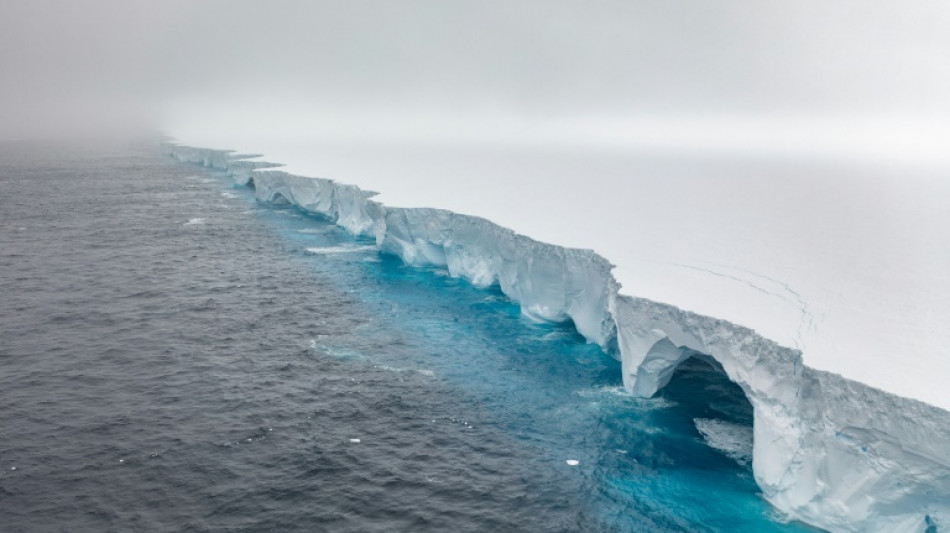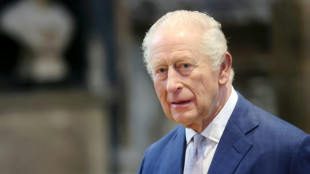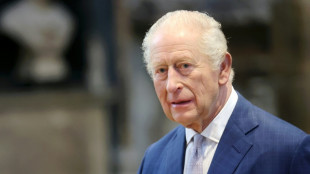
-
 North Korea acknowledges its troops cleared mines for Russia
North Korea acknowledges its troops cleared mines for Russia
-
US unseals warrant for tanker seized off Venezuelan coast

-
 Cambodia says Thailand still bombing hours after Trump truce call
Cambodia says Thailand still bombing hours after Trump truce call
-
Machado urges pressure so Maduro understands 'he has to go'

-
 Leinster stutter before beating Leicester in Champions Cup
Leinster stutter before beating Leicester in Champions Cup
-
World stocks mostly slide, consolidating Fed-fuelled gains

-
 Crypto firm Tether bids for Juventus, is quickly rebuffed
Crypto firm Tether bids for Juventus, is quickly rebuffed
-
Union sink second-placed Leipzig to climb in Bundesliga

-
 US Treasury lifts sanctions on Brazil Supreme Court justice
US Treasury lifts sanctions on Brazil Supreme Court justice
-
UK king shares 'good news' that cancer treatment will be reduced in 2026

-
 Wembanyama expected to return for Spurs in NBA Cup clash with Thunder
Wembanyama expected to return for Spurs in NBA Cup clash with Thunder
-
Five takeaways from Luigi Mangione evidence hearings

-
 UK's king shares 'good news' that cancer treatment will be reduced in 2026
UK's king shares 'good news' that cancer treatment will be reduced in 2026
-
Steelers' Watt undergoes surgery to repair collapsed lung

-
 Iran detains Nobel-prize winner in 'brutal' arrest
Iran detains Nobel-prize winner in 'brutal' arrest
-
NBA Cup goes from 'outside the box' idea to smash hit

-
 UK health service battles 'super flu' outbreak
UK health service battles 'super flu' outbreak
-
Can Venezuela survive US targeting its oil tankers?

-
 Democrats release new cache of Epstein photos
Democrats release new cache of Epstein photos
-
Colombia's ELN guerrillas place communities in lockdown citing Trump 'intervention' threats

-
 'Don't use them': Tanning beds triple skin cancer risk, study finds
'Don't use them': Tanning beds triple skin cancer risk, study finds
-
Nancy aims to restore Celtic faith with Scottish League Cup final win

-
 Argentina fly-half Albornoz signs for Toulon until 2030
Argentina fly-half Albornoz signs for Toulon until 2030
-
Trump says Thailand, Cambodia have agreed to stop border clashes

-
 Salah in Liverpool squad for Brighton after Slot talks - reports
Salah in Liverpool squad for Brighton after Slot talks - reports
-
Marseille coach tips Greenwood as 'potential Ballon d'Or'

-
 Draw marks 'starting gun' toward 2026 World Cup, Vancouver says
Draw marks 'starting gun' toward 2026 World Cup, Vancouver says
-
Thai PM says asked Trump to press Cambodia on border truce

-
 Salah admired from afar in his Egypt home village as club tensions swirl
Salah admired from afar in his Egypt home village as club tensions swirl
-
World stocks retrench, consolidating Fed-fuelled gains

-
 Brazil left calls protests over bid to cut Bolsonaro jail time
Brazil left calls protests over bid to cut Bolsonaro jail time
-
Trump attack on Europe migration 'disaster' masks toughening policies

-
 US plan sees Ukraine joining EU in 2027, official tells AFP
US plan sees Ukraine joining EU in 2027, official tells AFP
-
'Chilling effect': Israel reforms raise press freedom fears

-
 Iran frees child bride sentenced to death over husband's killing: activists
Iran frees child bride sentenced to death over husband's killing: activists
-
No doubting Man City boss Guardiola's passion says Toure

-
 Youthful La Rochelle name teen captain for Champions Cup match in South Africa
Youthful La Rochelle name teen captain for Champions Cup match in South Africa
-
World stocks consolidate Fed-fuelled gains

-
 British 'Aga saga' author Joanna Trollope dies aged 82
British 'Aga saga' author Joanna Trollope dies aged 82
-
Man Utd sweat on Africa Cup of Nations trio

-
 EU agrees three-euro small parcel tax to tackle China flood
EU agrees three-euro small parcel tax to tackle China flood
-
Taylor Swift breaks down in Eras documentary over Southport attack

-
 Maresca 'relaxed' about Chelsea's rough patch
Maresca 'relaxed' about Chelsea's rough patch
-
France updates net-zero plan, with fossil fuel phaseout

-
 Nowhere to pray as logs choke flood-hit Indonesian mosque
Nowhere to pray as logs choke flood-hit Indonesian mosque
-
In Pakistan, 'Eternal Love' has no place on YouTube

-
 England bowling great Anderson named as Lancashire captain
England bowling great Anderson named as Lancashire captain
-
UK's King Charles to give personal TV message about cancer 'journey'

-
 Fit-again Jesus can be Arsenal's number one striker, says Arteta
Fit-again Jesus can be Arsenal's number one striker, says Arteta
-
Spain's ruling Socialists face sex scandal fallout among women voters


World's biggest iceberg 'battered' by waves as it heads north
It was impossible to see through the snow and fog on the Antarctic seas but expedition leader Ian Strachan knew his ship was approaching a true behemoth: the world's biggest iceberg lay somewhere ahead.
"Then the clouds lifted and we could see this expansive -- almost abstract -- white line that extended each way across the horizon," he told AFP.
As the ship got closer during its visit on Sunday, huge gaping crevasses and beautiful blue arches sculpted into the edge of the iceberg came into focus.
Waves up to four metres (13 feet) high "smashed" and "battered" its wall, breaking off small chunks and collapsing some arches, Strachan said.
He compared sailing along the endless jagged edge to looking at sheet music. "All the cracks and arches were different notes as the song played."
The tooth-shaped iceberg named A23a is nearly 4,000 square kilometres (1,550 square miles) across, making it more than twice the size of Greater London.
After three decades stuck to the Antarctic ocean floor, the iceberg is now heading north on what could be its final journey.
It contains an estimated one trillion tonnes of fresh water that is likely to melt off into the ocean along way.
The iceberg, which is up to 400 metres thick in places, is currently drifting between Elephant Island and the South Orkney islands.
- 'Magical' -
Strachan was speaking to AFP as his ship, run by the expeditions firm EYOS, was wrapping up a private tour of the Antarctic Peninsula.
It had been planning to go to South Georgia island but due to a bird flu outbreak there, it visited A23a instead.
It was not the first ship to witness the majesty of the iceberg.
The UK's RRS Sir David Attenborough was travelling to Antarctica on a scientific mission last month, when it found the A23a blocking its path.
Andrew Meijers, the chief scientist on board, said that when they approached the iceberg, the mist parted, the sun came out and a pod of orcas even swam past.
"It was really magical," Meijers told AFP.
"It took us six hours to steam past it," he added.
A23a first broke off the Antarctic coast back in 1986, making it the world's oldest iceberg, as well as its largest.
But it quickly became stuck to the ocean floor, where it languished for decades.
Andrew Fleming of the British Antarctic Survey told AFP that in 2020 he saw satellite images suggesting it was "wobbling".
Then late last year, A23a broke free from its icy shackles and started venturing north.
Whether or not this was caused by climate change -- winter Antarctic sea ice reached its lowest level on record last year -- remains an open question.
Fleming emphasised that these icebergs are a natural process, adding that one or two big ones break off every year.
"It's more likely that it's time had just come," he added.
But he emphasised that such icebergs are "part of a huge system that is changing dramatically".
- 'Lumbering beast' -
This "lumbering beast" moves slower than walking pace, Fleming said.
"The Titanic would've spotted this one coming."
Since breaking free, A23a has followed roughly the same path as previous massive icebergs A68 and A76, moving past the east side of the Antarctica Peninsula through the Weddell Sea along a route called "iceberg alley".
As the iceberg is "ejected out into the Southern Ocean", warmer waters and bigger waves will start to break it up, Fleming said.
If it follows the path of the two comparably huge previous icebergs, it will travel northeast towards the island of South Georgia, a haven for wildlife including penguins and seals.
There is a slight fear that if the iceberg parks itself near the island, it could block these animals from getting to where they normally forage, threatening their ability to feed themselves.
But this is not expected to happen.
A68 instead broke up into smaller chunks, causing a problem not for animals but humans, making it difficult for fishing ships to navigate the area, Meijers said.
A more likely path would be for A23a to move around the island and continue meandering northwards.
A rare few icebergs have made it so far that they have been spotted from the Brazilian coast.
But eventually A23a will meet the fate of all icebergs that journey north -- melting away in warmer waters.
"Ultimately, they're doomed," Fleming said.
M.A.Colin--AMWN


